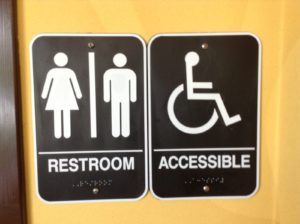
Save the WaterTM celebrated World Water Day 2019 in March by highlighting this year’s theme: “Leaving no one behind.”1 While clean water access is a global mission, many people face unique struggles due to their social and economic standing. Therefore, real solutions must include everyone. In recent years, the public has become more aware of the ways that people with disabilities are denied their right to water.
Defining Disability
The International Classification of Functioning, Disability, and Health defines disability as, “a limitation in a functional domain that arises from the interaction between a person’s intrinsic capacity and environmental and personal factors.”2 It can be permanent or temporary, from birth or developed later in life, and visible or invisible.
One in every seven people is disabled to some extent.3 Poverty increases one’s susceptibility to health problems. As a result, about 80% of the global disabled population lives in low-income countries.4
Disability and Water Access
The acronym WASH, invented by the United Nations, stands for “water, sanitation, and hygiene.”2 It is a useful guide for learning the different parts of full water access. When it comes to WASH, people with disabilities face both physical and social barriers. Toilet facilities contain physical barriers such as:4
- No toilet in the disabled person’s home
- Nearest toilet is crowded or far away
- Steps to reach the toilet
- Narrow toilet stalls or entrances
- Dark facilities without an accessible light switch
- Doors that are heavy or have handles that are hard to reach
- Slippery floors
- Out-of-reach controls for flushing and handwashing
- Lack of support for disabled people to lift themselves onto and off the toilet
Social barriers are often invisible to the able-bodied. However, they are no less harmful:4
- Ignorance or hostility from family, peers, teachers, employers, and even the facility’s designers
- Lack of privacy, as disabled persons may need help to use facilities
- The extra amount of time that some people require to use the facilities may result in negative consequences for students and employees2
- Lack of a voice or listeners to express their concerns
As you can see, these barriers undermine the health and dignity of people with disabilities. The absence of adequate facilities affects relationships, school enrollment, and employment. In severe cases, people with disabilities may be forced to defecate outside of toilet facilities. Consequently, they become more prone to infectious disease.5
How to Help
Thanks to the attention and research given to this issue, guidelines for accessible WASH facilities have been developed in partnership with Disabled People’s Organizations (DPOs) and disabled individuals. You can improve an entire community’s quality of life with the right knowledge and some small design tweaks.
In one success story, the Sustainable Sanitation and Hygiene for All program gave key individuals in six districts in Waghimra, Ethiopia training in WASH for disabled people. They also published a booklet on accessible toilets. As a result, the rate of defecation outside of toilet facilities dropped from 77.1 percent to 3.3 percent in three years.5
How can you help? You have already taken the first step by learning about this issue. If you don’t have a disability, you should listen to and boost the voices of disabled persons. Do your part to lessen social barriers to water access.
Works Cited
- UN Water. 2019. “Theme.” https://www.worldwaterday.org/theme/
- United Nations. 2018. “Realization of the sustainable development goals by, for, and with persons with disabilities.” https://bit.ly/2SvvNbX
- World Bank. 2017. “Including persons with disabilities in water sector operations: A guidance note.” https://bit.ly/2TCOH0F
- Gregor Wolbring and Jacqueline Noga. November 12, 2012. “The Economic and Social Benefits and the Barriers of Providing People with Disabilities Accessible Clean Water and Sanitation.”Sustainability, 4, 3023-3041. https://www.unicef.org/disabilities/files/sustainability-04-03023.pdf
- SNV. June 2017. “Improving the lives of people with disabilities through better sanitation and hygiene.” https://bit.ly/2JQ3pBF

